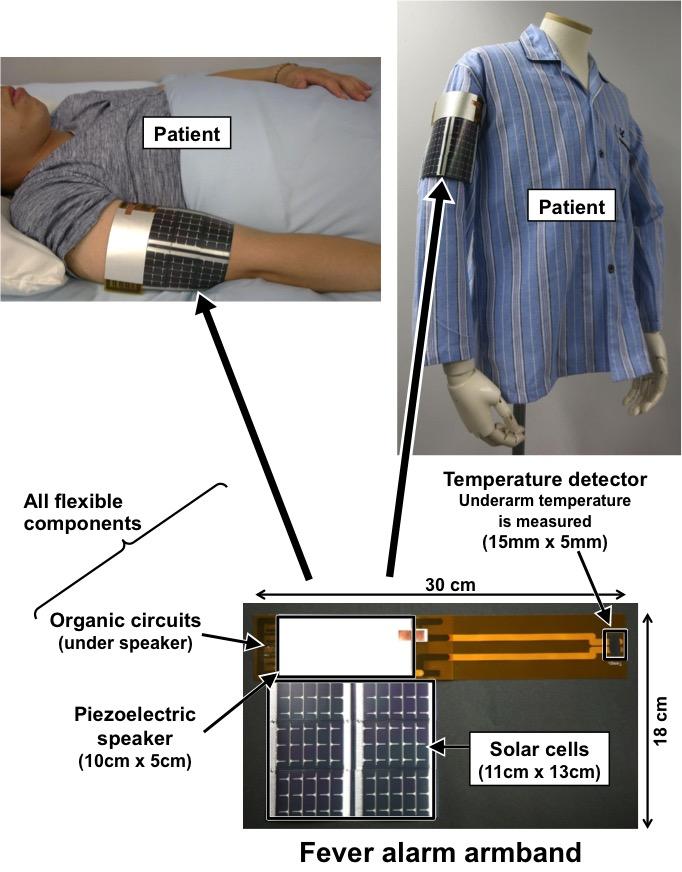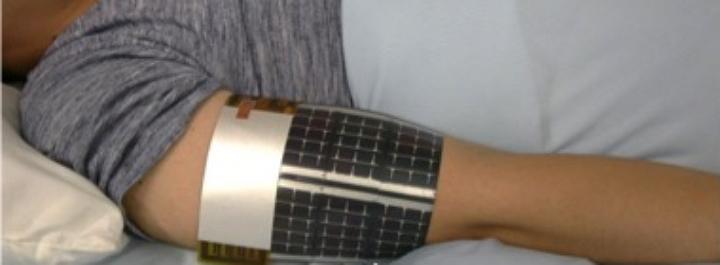Researchers at the University of Tokyo have built what they call a “fever alarm armband” capable of monitoring the vital signs of hospital patients using 3D inkjet printing. It’s a flexible, self-powered wearable device, and the armband trips an alarm if a patient displays an abnormally high body temperature.
Professor Takayasu Sakurai, the leader of the research group of the Institute of Industrial Science, and Professor Takao Someya, of the Graduate School of Engineering, say the flexible organic components developed for their device are also applicable to wearable devices that could continuously monitor other vital signs such as a patient’s temperature or heart rate.
The device combines a flexible, amorphous silicon solar panel, a piezoelectric speaker, a temperature sensor and a power supply circuit – all created with organic components – and results in a flexible, wearable unit.
The researchers said they were focused on developing a sensor which is flexible and includes wireless connectivity. The sensor needed to provide maximum patient comfort, be relatively maintenance-free, and to operate without an external energy supply.
Another factor was a requirement that the sensors be cheap to manufacture so as to make them disposable and hygienic. The University of Tokyo team developed the flexible solution, and it can be fabricated using an inkjet-like printer on a polymeric film.
The armband is 12 inches long and 7 inches wide, and it can be worn directly on the skin or on top of clothing. The design places the thermal sensor between the arm and the body, and the organic solar power supply circuit is located under the piezo film speaker to reduce surface area.
Sakurai says the device creates electric power generated by room light.
The flexible solar cells and the piezoelectric film speakers may also be adapted to a wide range of applications, and Sakurai adds that the organic circuit is the first to be capable of both producing a sound output and incorporating an organic power supply circuit.
 The speaker was designed to sound an audible alarm, and the flexible thermal sensor can detect temperature changes from between 36.5 ºC to 38.5 ºC.
The speaker was designed to sound an audible alarm, and the flexible thermal sensor can detect temperature changes from between 36.5 ºC to 38.5 ºC.
“Our fever alarm armband demonstrates that it is possible to produce flexible, disposable devices that can greatly enhance the amount of information available… in healthcare settings,” says Someya. “We have demonstrated the technology with a temperature sensor and fever alarm, but the system could also be adapted to provide audible feedback on body temperature, or combined with other sensors to register wetness, pressure or heart rate.”
The team’s work was published in a paper entitled “Energy Autonomous Fever Alarm Armband Integrating Fully Flexible Solar Cells, Piezoelectric Speaker, Temperature Detector, and 12V Organic Complementary FET Circuits,” and it will be delivered at the IEEE International Solid State Circuits Conference in San Francisco this week.
The research team included Hiroshi Fuketa, Masamune Hamamatsu, Tomoyuki Yokota, Wakako Yukita, Teruki Someya, Tsuyoshi Sekitani and Makoto Takamiya as well as Someya and Sakurai, and funding was provided by the University of Tokyo.
Have you seen any other novel uses of 3D printing like this patient alarm device from the University of Tokyo? Let us know in the Solar Powered Thermal Alarm forum thread on 3DPB.com.
Subscribe to Our Email Newsletter
Stay up-to-date on all the latest news from the 3D printing industry and receive information and offers from third party vendors.
You May Also Like
Gorilla Sports GE’s First 3D Printed Titanium Cast
How do you help a gorilla with a broken arm? Sounds like the start of a bad joke a zookeeper might tell, but it’s an actual dilemma recently faced by...
Nylon 3D Printed Parts Made More Functional with Coatings & Colors
Parts 3D printed from polyamide (PA, Nylon) 12 using powder bed fusion (PBF) are a mainstay in the additive manufacturing (AM) industry. While post-finishing processes have improved the porosity of...
$25M to Back Sintavia’s Largest Expansion of Metal 3D Printing Capacity Since 2019
Sintavia, the digital manufacturing company specializing in mission-critical parts for strategic sectors, announced a $25 million investment to increase its production capacity, the largest expansion to its operations since 2019....
Velo3D Initiates Public Offering in a Bid to Strengthen Financial Foundations and Drive Future Growth
Velo3D (NYSE: VLD) has been among a number of publicly traded 3D printing firms that have attempted to weather the current macroeconomic climate. After posting a challenging financial report for 2023,...

































